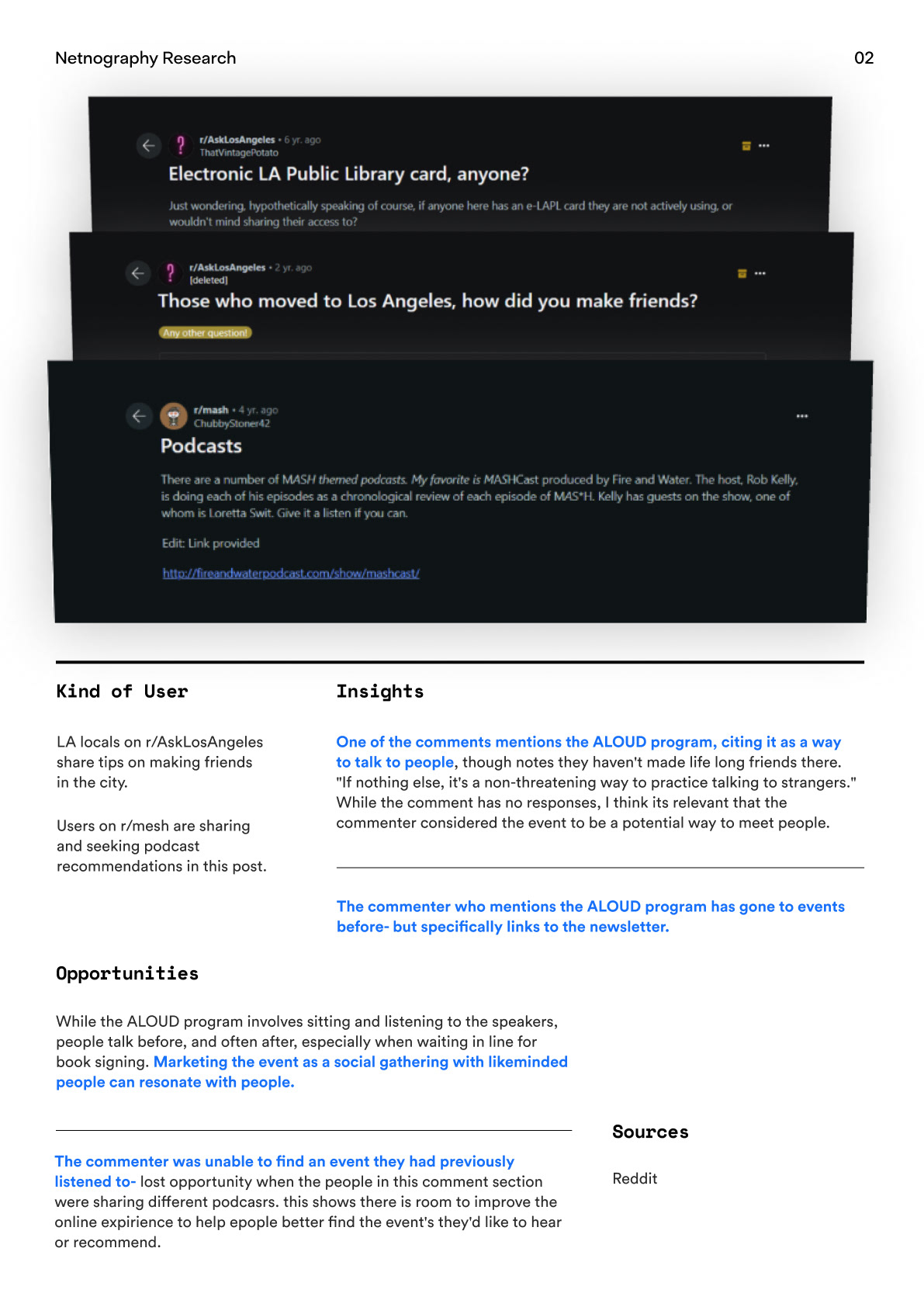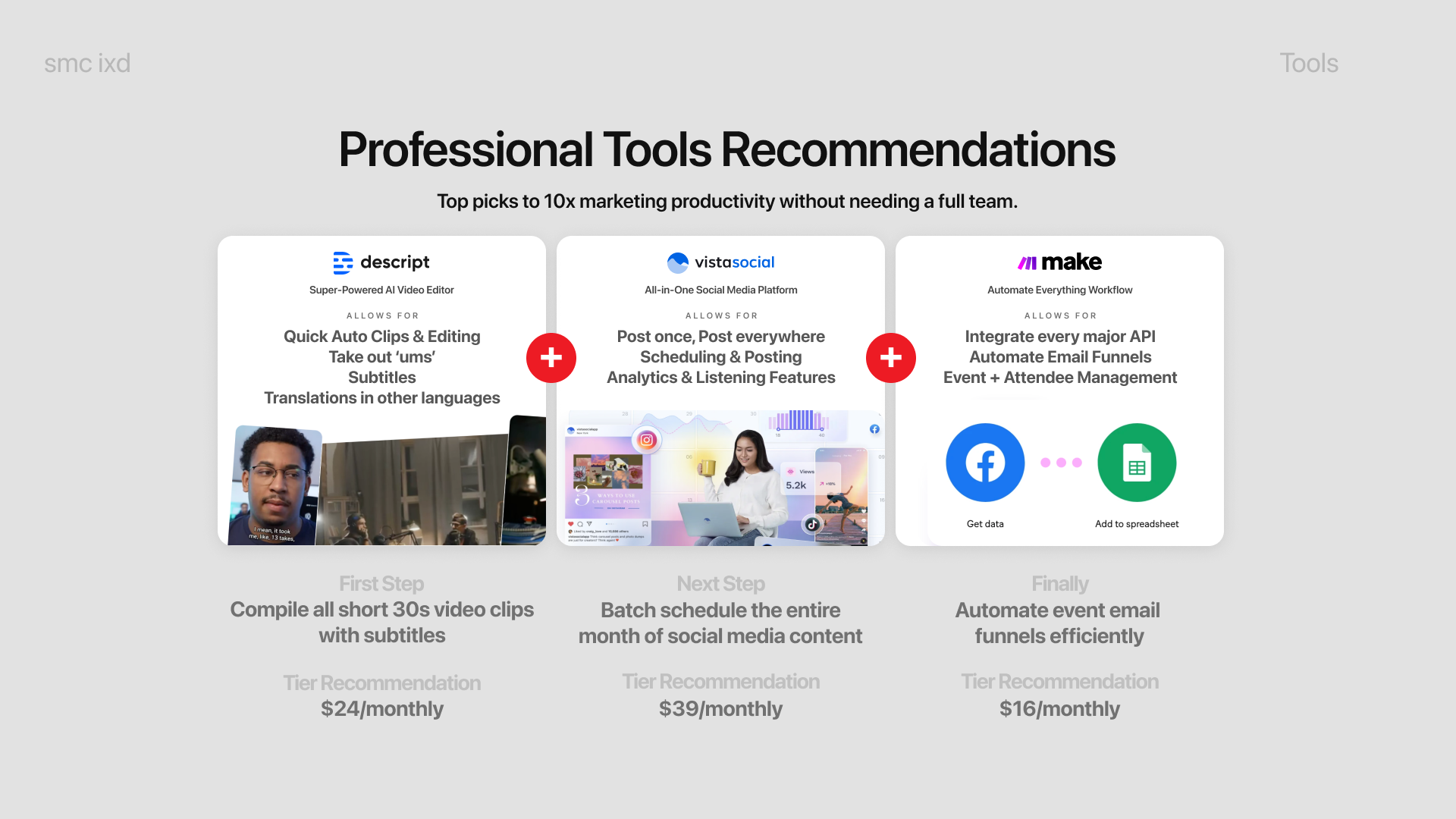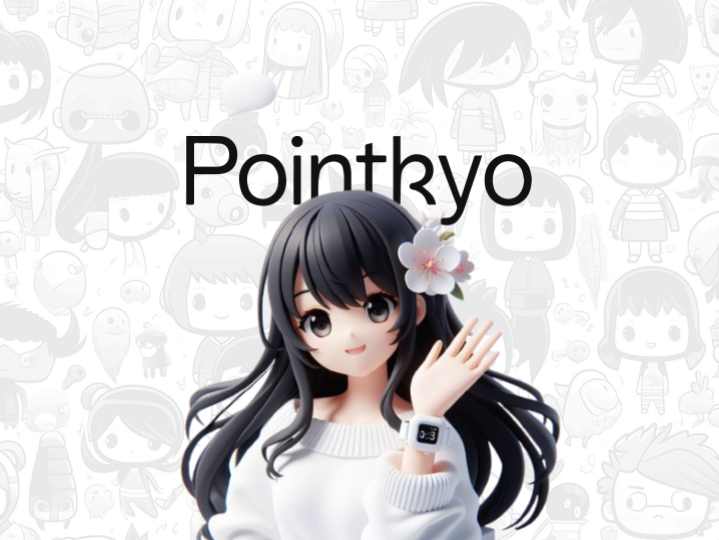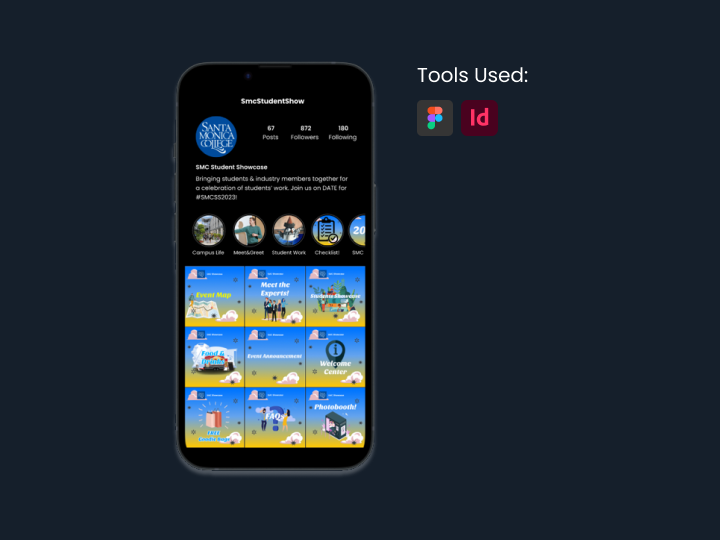Reimagining Digital Engagement for ALOUD: A UX/UI and Service Design Approach.
Description:
We developed a comprehensive rebranding and marketing strategy to enhance audience engagement, expand ALOUD's reach, and increase community interaction.
Academic Project
Role
UX Researcher, Brand & Marketing Strategist, Graphic Designer
Year
Fall 2024 (16 weeks)
Team
Project Brief:
The ALOUD program is a cultural and educational initiative by the Library Foundation of Los Angeles (LFLA). The project aimed to rebrand the program, focusing on increasing visibility and engagement through more relevant, dynamic marketing strategies. This included a revamp of social media strategies, including Instagram posts, behind-the-scenes content, and community-centered storytelling.
OVERVIEW/ PROJECT CHALLENGE
Problem
ALOUD struggled to engage younger, diverse audiences. The current social media efforts lacked consistent and relevant messaging, making it difficult for the target audience to connect with the program.
ALOUD struggled to engage younger, diverse audiences. The current social media efforts lacked consistent and relevant messaging, making it difficult for the target audience to connect with the program.
Insight
Through stakeholder interviews and research, we discovered that the community resonates with authentic, relatable content. Social media was underutilized, and there was a lack of storytelling that reflected the program's values and cultural relevance.
Through stakeholder interviews and research, we discovered that the community resonates with authentic, relatable content. Social media was underutilized, and there was a lack of storytelling that reflected the program's values and cultural relevance.
Solution
We proposed and executed a social media takeover for an ALOUD event, increasing engagement through real-time Instagram Stories, behind-the-scenes content, and event highlights. We also developed a new cohesive rebranding strategy that focuses on inclusivity and cultural relevance, aiming to connect with both younger and older audiences.
RESEARCH + PROCESS
The process for ALOUD's rebranding and marketing strategy involved multiple stages of research, ideation, and design. Below are the key steps with a focus on my individual contributions to the project:
1. Research Tools: Secondary Research
My role in the research phase was conducting secondary research to gather valuable information about audience trends, cultural program marketing strategies, and user behaviors. I analyzed reports, articles, and case studies to understand how similar cultural programs are engaging their communities, particularly through digital platforms. This research informed our understanding of the broader landscape and helped guide the rebranding direction for ALOUD.

Secondary Research 1

Secondary Research 2

Secondary Research 3
In addition to my secondary research, the team collectively conducted:
• Competitive Analysis: To benchmark ALOUD’s current strategies against similar cultural organizations.

Competitive Analysis - Big Think

Competitive Analysis - DO

Competitive Analysis - TedTalk
• Informed Design: To ensure that our design solutions addressed real user needs.

Informed Design Summary

Informed Design - Data Analytics

Informed Design Insights
• Netnography: To analyze social media conversations and uncover audience engagement opportunities.

Netnography - Reddit

Netnography - TikTok

Netnography - Key Points
2. Subject Matter Expert Interviews
I, along with Anna, conducted interviews with Subject Matter Experts (SMEs), including Bree Von Faith and Allison Samek. These interviews provided insights into effective marketing strategies, the importance of aligning with community values, and how authentic storytelling can create meaningful connections.
SME Interview with Bree Von Faith
In addition, I conducted a tiny experiment by informally interviewing an ALOUD attendee. This helped me understand why loyal attendees continue participating in ALOUD events and revealed opportunities for improving outreach and event engagement.
Tiny Experiment with ALOUD Patron
3. Customer Journey Mapping
We created a customer journey map to visualize the attendee experience from initial discovery to post-event reflection. This process highlighted key barriers in the current engagement process, such as the lack of visibility in marketing and limited pre- and post-event communication. By mapping these pain points, we identified strategic opportunities to improve the user experience.
ALOUD Marketing/Branding Customer Journey Map
4. Prototyping and Graphic Design for Social Media
In the design phase, I took on the role of graphic designer to create Instagram prototypes for ALOUD’s rebranded social media presence. I designed templates for Instagram posts and Stories, incorporating event highlights, attendee testimonials, and engaging visual content.
The prototypes emphasized consistency, authenticity, and a visually appealing style that resonated with ALOUD’s target audience while showcasing its cultural and literary value.
Instagram Post Branding Prototypes
5. Stakeholder Feedback
During our midterm presentation, stakeholders praised the team's effort, especially the use of the developing branding. They requested demonstrations of the recommended tools and more clarity on managing post and email volumes across the organization.
In response, we’ll ensure consistent branding, refine the video with slower pacing and more detailed explanations, and add tool demonstrations. We’ll also explore ways to streamline tool usage across the organization. Additionally, I incorporated insights from attendee interviews and SME conversations to ensure the rebranded content reflects the community’s values.

AI Tools Recommendations

Updated Marketing Plan for Social Media
RESULTS
The final deliverable for this project focused on rebranding ALOUD’s digital presence, which included a set of Instagram posts, a visual style guide, and recommendations for improved engagement strategies. Our Instagram posts incorporated the new branding elements, emphasizing visual consistency and clarity while ensuring the content was dynamic and engaging for the audience.
Key features of the final product include:
• Brand Consistency: All graphics followed the newly established color palette, typography, and logo usage, creating a cohesive visual identity.
• Engagement Strategy: The posts were designed to generate community engagement, featuring attendee testimonials, event highlights, and direct calls to action to increase awareness.
• Content Demonstrations: We proposed demonstrating some recommended tools for social media management to help ALOUD streamline content creation and scheduling.
Updated ALOUD Branding
REFLECTION
After completing this project, I can say that I am more confident in my abilities as a UX designer and design student. Despite facing challenges such as the school shooting, shifting stakeholder directions, and the design agency being hired mid-project, I was able to adapt and deliver solutions aligned with stakeholder needs.
One surprising thing I encountered was how much stakeholder feedback shaped the design process. It often led us to reevaluate our initial approach, resulting in a more user-centered outcome.
I faced several constraints, including time limitations, shifting project scope, and unexpected changes. Managing these challenges involved prioritizing key tasks, maintaining communication, and finding creative solutions.
Looking back, I wish I had implemented more user testing earlier in the design process to identify issues sooner. I could have also maintained a more flexible approach, being more open to feedback and proactively addressing constraints to improve the project flow.
Some possible next steps include refining our marketing strategy, developing more promotional materials, and continuing to enhance the tools and strategies we've proposed.









